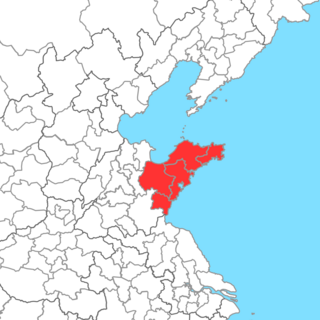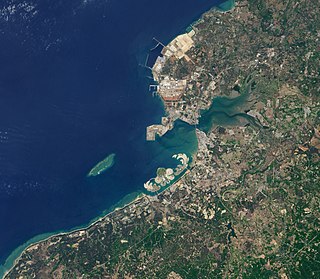Contents
This article needs additional citations for verification .(November 2024) |

The peninsulas of China by province or region:
This article needs additional citations for verification .(November 2024) |

The peninsulas of China by province or region:

The Treaty of Shimonoseki, also known as the Treaty of Maguan in China and Treaty of Bakan in the period before and during World War II in Japan, was an unequal treaty signed at the Shunpanrō hotel, Shimonoseki, Japan on April 17, 1895, between the Empire of Japan and Qing China, ending the First Sino-Japanese War.

Shandong is a coastal province in East China. Shandong has played a major role in Chinese history since the beginning of Chinese civilization along the lower reaches of the Yellow River. It has served as a pivotal cultural and religious center for Taoism, Chinese Buddhism and Confucianism. Shandong's Mount Tai is the most revered mountain of Taoism and a site with one of the longest histories of continuous religious worship in the world. The Buddhist temples in the mountains south of the provincial capital of Jinan were once among the foremost Buddhist sites in China. The city of Qufu was the birthplace of Confucius, and later became the center of Confucianism.

Dalian is a major sub-provincial port city in Liaoning province, People's Republic of China, and is Liaoning's second largest city and the third-most populous city of Northeast China. Located on the southern tip of the Liaodong peninsula, it is the southernmost city in both Liaoning and the entire Northeast. Dalian borders the prefectural cities of Yingkou and Anshan to the north and Dandong to the northeast, and also shares maritime boundaries with Qinhuangdao and Huludao across the Liaodong Bay to west and northwest, Yantai and Weihai on the Shandong peninsula across the Bohai Strait to the south, and North Korea across the Korea Bay to the east.

Qingdao is a prefecture-level city in the eastern Shandong Province of China. Located on China's Yellow Sea coast, Qingdao was founded in 1891 to support coastal defence fortifications. In 1897, the city was ceded to Germany. For the Germans Qingdao (Tsingtau) was a strategic trade center, port and base for its East Asia Squadron, allowing the German navy to project dominance in the Pacific. In 1914, following the outbreak of World War I, Japan occupied the city and the surrounding province during the Siege of Tsingtao. In 1915, China agreed to recognize Japan's special position in the territory through what became known as the Twenty-One Demands. In 1918, the Chinese government, under the control of the warlord Duan Qirui, secretly agreed to Japanese terms in exchange for a loan. Following the First World War, during the Paris Peace Conference, Japan secured agreements with the Allied powers to recognize its claim to the areas in Shandong, which included Qingdao, previously occupied by Germany. In 1922, Shandong reverted to Chinese control following the United States' mediation during the Washington Naval Conference. Today, Qingdao is a major nodal city of the Belt and Road Initiative (BRI) that connects Continental and East Asia with Europe. It has the highest GDP of any city in the province.

The Liaodong or Liaotung Peninsula is a peninsula in southern Liaoning province in Northeast China, and makes up the southwestern coastal half of the Liaodong region. It is located between the mouths of the Daliao River in the west and the Yalu River in the east, and encompasses the territories of the whole sub-provincial city of Dalian and parts of prefectural cities of Yingkou, Anshan and Dandong.

Lüshunkou District is a district of Dalian, Liaoning province, China. The district's area is 512.15 km2 (197.74 sq mi) and its permanent population as of 2020 is 398,579.

The Shandong (Shantung) Peninsula or Jiaodong (Chiaotung) Peninsula is a peninsula in Shandong in eastern China, between the Bohai Sea to the north and the Yellow Sea to the south. The latter name refers to the east and Jiaozhou.

Weihai, formerly Weihaiwei, is a prefecture-level city and major seaport city in the easternmost Shandong province of China. It borders Yantai to the west and the Yellow Sea to the east, and is the closest mainland Chinese city to South Korea.

Laizhou Bay is a bay on the southern shore of the Bohai Sea, bounded by the northwestern coastline of the Shandong Peninsula west of the Port of Longkou and the eastern coastline of Dongying south of the Yellow River estuary. It is named after the county-level city of Laizhou to its east, and is the smallest of the three main bays of the Bohai Sea.

The Nishisonogi Peninsula, also called Seihi Peninsula, is a peninsula in northwest Kyūshū, Japan. It is the north-northwesterly fork of a larger peninsula which also includes Nagasaki and the Nomo Peninsula. To its west is the East China Sea, while to the east it encloses Ōmura Bay.

The Qingdao–Jinan railway or Jiaoji Railway is a railway in Shandong Province, China. The railway is 393 kilometres (244 mi) in length and connects Qingdao, on the Jiaozhou Bay, and Jinan, the provincial capital of Shandong. Adolph von Hansemann and other German financiers funded construction of the railway, then known as Schantung Eisenbahn Gesellschaft, which began September 23, 1899, and was completed in 1904. Since the quadruple tracking of this corridor with the opening of the parallel Qingdao–Jinan passenger railway, the line is mostly used for freight with some conventional passenger services.

China's coastline covers approximately 14,500 km from the Bohai gulf in the north to the Gulf of Tonkin in the south. Most of the northern half is low lying, although some of the mountains and hills of Northeast China and the Shandong Peninsula extend to the coast. The southern half is more irregular. In Zhejiang and Fujian provinces, for example, much of the coast is rocky and steep. South of this area the coast becomes less rugged: Low mountains and hills extend more gradually to the coast, and small river deltas are common. The southern coast on the South China Sea is also low, with sweeping hills and plains.

The Bohai Economic Rim (BER) or Bohai Bay Economic Rim (BBER) is the economic region surrounding Tianjin (Tientsin). It also includes areas in Hebei, Liaoning and Shandong surrounding the Bohai Sea. This region has undergone major economic and infrastructural changes and is an emerging economic powerhouse of North China, rivaling both the Pearl River Delta in southern China and the Yangtze River Delta in eastern China.

Dapeng Peninsula or Dapengbandao (大鹏半岛) is a peninsula in the east of Longgang district, that lies in the easternmost part of Shenzhen in the Guangdong Province in China. To the southwest of the peninsula is Mirs Bay and to the northeast is Daya Bay. The Dapeng dialect is the main dialect across the whole peninsula. The Dapeng Fortress (Dapengcheng) was built to protect the inhabitants from attacks by Japanese pirates (wokou) during the late Ming Dynasty. During the Second Opium War there was a possibility of annexation as part of British Hong Kong. Ultimately the area was never occupied by the British. During the Cultural Revolution the region saw a major famine, just like the rest of rural China.

The Bohai Sea is a gulf/inland sea approximately 77,000 km2 (30,000 sq mi) in area on the east coast of Mainland China. It is the northwestern and innermost extension of the Yellow Sea, to which it connects via the Bohai Strait. It has a mean depth of approximately 18 meters (59 ft), with a maximum depth of about 80 meters (260 ft) located in the northern part of the Bohai Strait.

The Yangpu Peninsula is a peninsula located in Danzhou, on the northwestern coast of Hainan Province, China. It has a 110 km (68 mi) coastline containing many natural harbors. An expressway connects the peninsula to Haikou, the capital of the province, which is 140 km (87 mi) to the east.
Zhang Wei is a Chinese author. He was born in Longkou, Yantai, which is located in the north of the Shandong Peninsula. He graduated from the Chinese Department at Yantai Normal College in 1980. Three years later, he became a member of China Writers Association, an organization for which he has served as chairman and deputy chairman of the Shandong branch. He is best known for his novels The Ancient Ship and September's Fable. In 2011 Zhang won the Mao Dun Literature Prize, the highest national literary award, for On the Plateau, a 10-volume work that took a decade to write.

The Liu'ao Peninsula is located in the southern part of China's Fujian Province's coast. Administratively, it is incorporated as Liu'ao Town within Fujian's Zhangpu County.

The Peninsula Beijing is a 5-star luxury hotel in Beijing. It was China's first luxury hotel when it opened as The Palace Hotel in 1989. The Peninsula Hotels, part of the Hong Kong And Shanghai Hotels Group, assumed management of the hotel in 1996 and renamed it The Peninsula Beijing in 2006. In 2017, the hotel completed a US$123 million renovation, becoming an all-suite hotel.
The China national para ice hockey team, established in 2017, represents the People's Republic of China in international sledge hockey competitions and is governed by the Winter Sports Management Center of the State Sports General Administration of China (国家体育总局冬季运动管理中心).